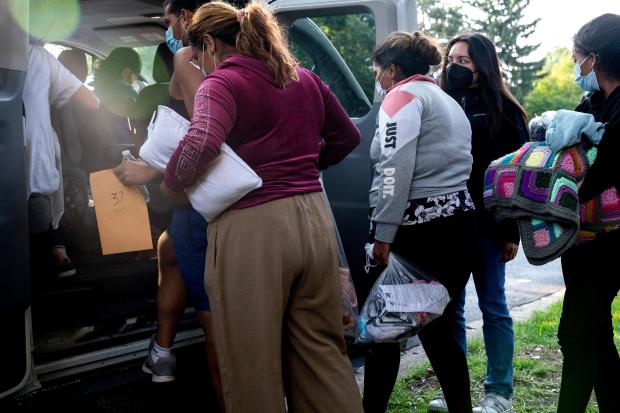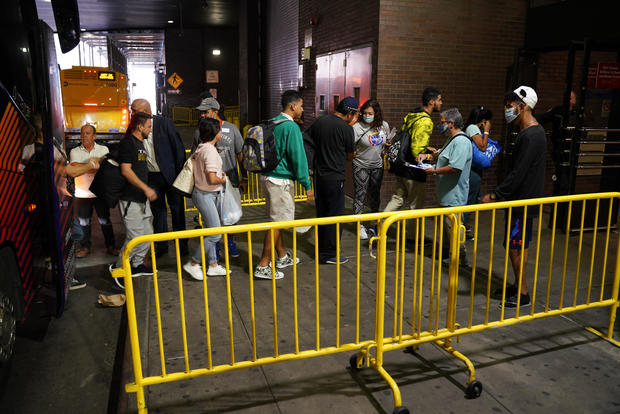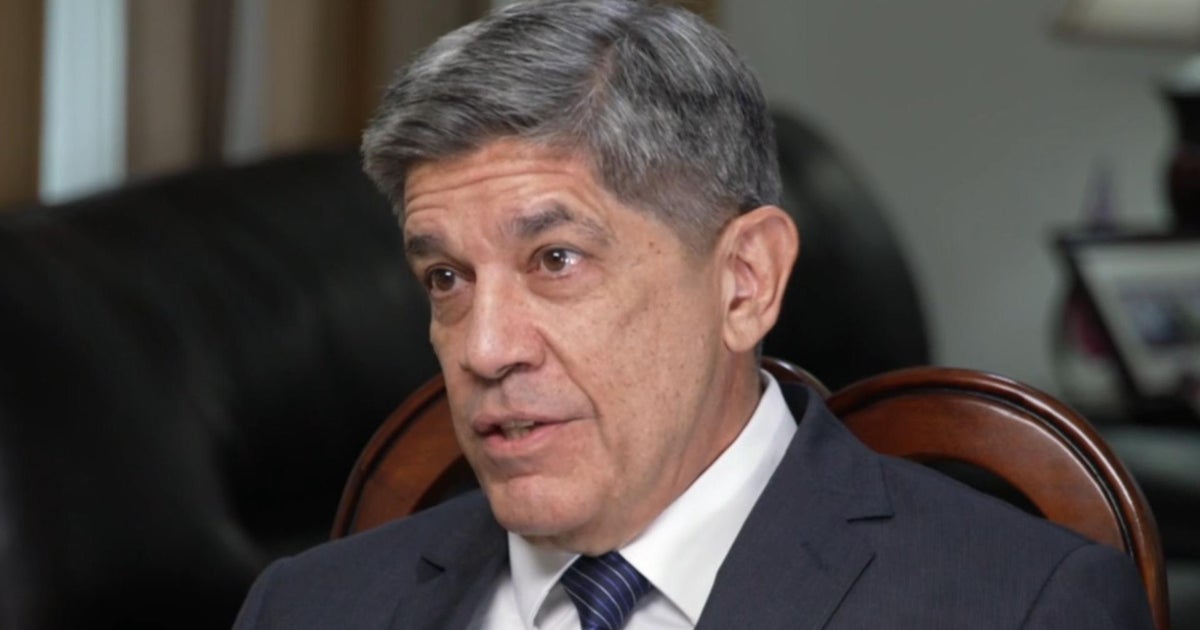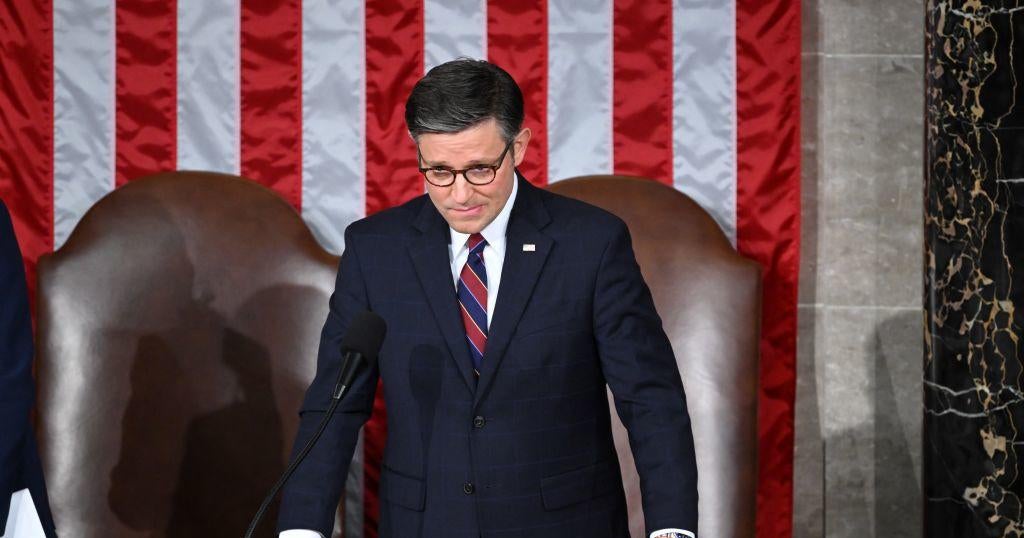The facts behind the Republican effort to send migrants to Democratic-led cities
The intensifying Republican-led efforts to protest President Biden's policies along the southern border by transporting migrants to Democratic-controlled jurisdictions like Martha's Vineyard and Washington, D.C., have reignited a decades-old, divisive debate over U.S. immigration policy.
The Biden administration, Democrats and advocates have called the transportation tactic a dehumanizing political stunt, accusing Republican-led states of using desperate asylum-seekers as props. Republican governors in Texas, Florida and Arizona have argued their efforts force Democratic cities to share the burden of accommodating migrants, which they say has fallen mostly on communities in their states.
Beyond the political back-and-forth, the busing and flying of migrants to locations selected by Republican officials has also raised questions about current border policies, who the people being transported are, what their legal status is, why they're in the U.S., what their futures hold and whether the states' actions are legal.
Here are the facts about the scheme by Republican-led states to bus and fly migrants to certain destinations.
Where are GOP governors transporting migrants?
In April, Texas Gov. Greg Abbott, a Republican, started busing migrants released from federal immigration custody in his state to D.C., saying he was "going to take the border" to the Biden administration, which he has accused of lax immigration enforcement.
Abbott expanded Texas' busing operation earlier this summer to include New York City and again earlier this month to include Chicago. On Sept. 15, Texas started off-loading migrants near Vice President Kamala Harris' official residence in D.C. Abbott has not ruled out including other cities or locations.
In May, Arizona Gov. Doug Ducey, a Republican, launched his own busing effort to transport migrants from his state to D.C. Arizona's operation has been smaller in scale than Texas' and limited to the capital. A spokesman for Ducey said there were no plans to transport migrants to other cities.
On Sept. 14, Florida Gov. Ron DeSantis, another Republican, took credit for the transportation of several dozen migrants to Martha's Vineyard, an island vacation destination off the Massachusetts coast. DeSantis said Florida will continue transporting migrants under a $12 million state program, but has not announced other destinations.
Why are these states doing this?
The Republican governors in Texas, Arizona and Florida have said their operation to transport migrants to so-called "sanctuary" jurisdictions is designed to pressure Democratic politicians and the Biden administration to enact tougher border measures to deter illegal crossings.
They've also argued that Democratic-controlled states and cities that have adopted "sanctuary" policies, which limit cooperation with federal immigration officials, should help border communities receive migrants amid the record levels of border arrests reported over the past year.
Federal authorities are expected to record more than 2 million migrant apprehensions along the U.S.-Mexico border in fiscal year 2022, a figure that will set an all-time high, according to Customs and Border Protection data. The statistic includes a significant number of repeat border crossings, as well as nearly 1 million rapid expulsions of migrants who were not allowed to stay in the U.S., the data show.
How many migrants have been transported?
Collectively, Texas and Arizona have transported roughly 13,000 migrants to Democratic-led cities on more than 300 buses in the past several months, according to data provided by state representatives.
As of Sept. 19, Texas had transported more than 8,100 migrants to D.C.; 2,600 to New York; and 675 to Chicago, state data show. Arizona, meanwhile, had bused more than 1,800 migrants to D.C., a spokesman for the governor said. The plane that landed in Martha's Vineyard on Sept. 14 transported roughly 50 migrants.
According to Texas' division of emergency management, the state's migrant busing operation has cost over $12 million. Arizona's busing effort, meanwhile, has cost over $4 million, the state spokesman said.
Why were these migrants released?
The migrants transported by Texas, Arizona and Florida were processed by federal border officials after entering the U.S. unlawfully and then released to continue their immigration cases inside the country.
Unlike other recent border-crossers, these migrants, for different reasons, were not expelled from the U.S. under a public health law known as Title 42, which border authorities have used to quickly turn away migrants over 2 million times since March 2020 without allowing them to request asylum.
Decisions to not expel migrants are based on different policy, logistical and diplomatic reasons. For example, as a policy matter, the Biden administration has not been expelling unaccompanied minors, who are instead transferred to shelters. Mexico also generally only accepts expulsions of its citizens and Central Americans.
Moreover, the federal government cannot expel migrants to Venezuela, Cuba or Nicaragua because the authoritarian regimes there don't accept U.S. deportations. Because of this, migrants from these countries are generally released by border officials after some short-term processing.
While Texas, Arizona and Florida have transported migrants from several countries, many of them hail from Venezuela and Cuba, which have seen a record number of their citizens flee to the U.S. in recent months.
Under U.S. law, migrants who are not processed under Title 42 have a legal right to seek asylum, which the government can grant to foreigners who demonstrate they could be persecuted in their home country because of their nationality, race, religion, political views or membership in a social group.
Do the migrants have legal status?
Just because a migrant is not expelled under Title 42 does not mean they have been granted permanent legal status in the U.S. or that they will not ultimately face deportation. But those released by the Department of Homeland Security (DHS) have been granted permission to continue their immigration cases inside the U.S.
Migrants who are released after crossing the border illegally are still placed in deportation proceedings before the immigration court system, where they can seek asylum or other forms of humanitarian refuge. They need to attend court hearings to try to halt their deportations, and could be ordered deported if they miss them.
Those who are granted asylum can stay in the U.S. permanently and those who lose their case can be ordered deported, but the adjudication process typically takes years to complete because of the mounting backlog of claims before the immigration courts, which are overseeing nearly 2 million unresolved cases.
Some migrants who are released by DHS are enrolled in "alternatives to detention" supervision programs that can include ankle monitors, other tracking devices and requirements to periodically check in with officials at local U.S. Immigration and Customs Enforcement offices.
Migrants processed by U.S. border officials, including at official ports of entry, are sometimes granted humanitarian parole, a temporary legal classification that shields them from deportation. While it does not provide migrants permanent legal status, parole makes their presence in the U.S. lawful.
Are the state operations legal?
When migrants are released by federal officials, they are allowed to travel to a U.S. destination of their choosing. And they can get there through various means, including the buses and planes that some Republican governors are offering them.
It's not illegal for states to transport migrants if it's voluntary. While critics have accused states of human trafficking and kidnapping, no proof has emerged that migrants have been forced on buses or planes. If the transportation involves coercion or false information, however, civil or criminal liability is possible, lawyers said.
Representatives for Texas and Arizona said their migrant busing operations to D.C., New York and Chicago are voluntary, noting they ask migrants to sign consent waivers. Representatives for Florida's governor did not say whether migrants transported by the state are informed the transportation is voluntary.
But lawyers representing more than two dozen migrants flown to Martha's Vineyard by Florida said their clients were misled by the people who transported them. According to the attorneys, the migrants said they were originally told they were going to Boston and a place with jobs and refugee services.
"It seems like there were clear elements of deception in this particular case. It seems like there was fraud in terms of their transport and what was represented to them," said Julie Dahlstrom, the director of the Immigrants' Rights and Human Trafficking Program at Boston University School of Law.
But Dahlstrom said federal and state officials would still need to determine whether there's sufficient evidence to prove that laws were violated, calling it a "difficult legal question."
Lawyers for Civil Rights, the group representing migrants flown to Martha's Vineyard, asked federal prosecutors and the Massachusetts attorney general to launch criminal investigations into their claims. California Gov. Gavin Newsom, a Democrat, has also urged the Justice Department to investigate the states' transportation efforts, including the question of whether migrants have been targeted because of their national origin, in violation of the 14th Amendment's equal protection clause.
Does the federal government also transport migrants?
To defend the actions of Texas, Arizona and Florida, Republican lawmakers have said the Biden administration also transports migrants to different states. But it's not an apples-to-apples comparison.
The federal government does transport certain migrants who cross the border unlawfully to locations across the country, but not to make a political statement — and the practice has been in place for decades, under Republican and Democratic administrations.
The Department of Health and Human Services, which is legally required to care for migrant children who cross the border without their parents, transports these unaccompanied minors, including on charter flights, to different locations to place them in a shelter or release them to relatives or other sponsors in the U.S.
ICE also transports some migrants arrested along the U.S. southern border to detention centers or to other regions of the border to alleviate overcrowding at holding facilities. Federal immigration officials sometimes fly migrants to different areas of the southern border where Mexico accepts their expulsion.






